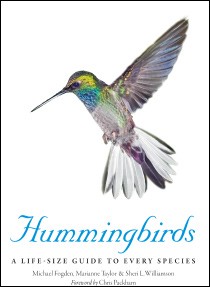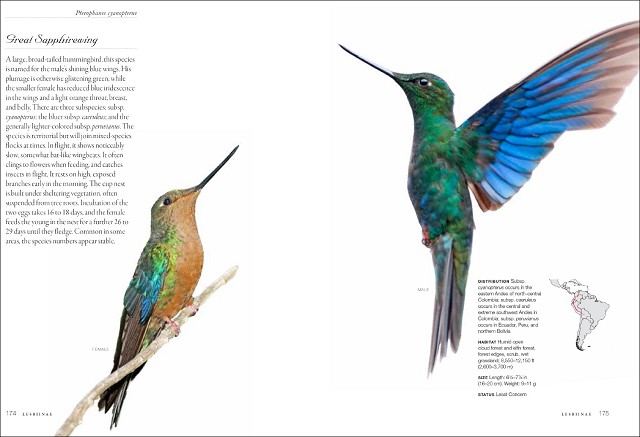Hummingbirds: a Life-size Guide to Every Species

Unsurprisingly, there is no shortage of publications dedicated to Trochilidae. Their character and beauty makes hummingbirds the subject of many tomes, some of which have done the family more justice than others. It therefore takes something a little bit special to stand out from the crowd, and Hummingbirds: a Life-size Guide to Every Species is just that.
First published as a hardback in 2014, the new paperback edition is now available. It's an extremely attractive title — the front cover is simple, uncluttered and striking, setting the tone for what is a crisply presented and aesthetically palatable guide. Plenty of white space and the compromising font ensures that the hummingbirds themselves are the stars of the show.
A foreward by Chris Packham is followed by an introductory section — evolution, taxonomy, ecology, plumage and migration are all covered and give a capable commencement to the subsequent species accounts.
A total of 338 species are profiled in the book's 'Hummingbird Directory' — “all 338 known species”, as the guide claims, but of course taxonomy is ever-evolving and the book does not, for example, recognise the recent split of Bearded Helmetcrest into four species. Each species is afforded a main paragraph of descriptive text, a distribution map and accompanying brief text covering distribution, habitat, size and IUCN status and, for 262 of the 338 covered taxa, a photograph.
Bar a very few exceptions, the photographic quality is of the highest order throughout. Each species is presented as a single cut-out photograph, which cements the bird as the sole focus of each page. Displaying the bird in this way ensures that there are no distracting backgrounds to derail the reader's attention and thus every minute detail of each species' plumage can be appreciated. This is particularly useful when one considers that the quality of illustrations in South American field guides is often lacking, and similar hummingbird species are often difficult to separate when seen in the field — this title is a something of a game-changer when it comes to appreciating and understanding the finer features of some of the more subtle species. This is helped by the life-size display of each species, which makes each photograph seem even more realistic and relevant.

The species accounts are presented in a simple and stylish design.
While perhaps a bit subject-specific to be carrying around in the field in South America, where there is such an abundance of other birdlife, this is a fantastic reference for the bookshelf. Not only is it a handy go-to guide for troublesome individuals encountered in the field, but the visual spectacle it offers ensures that it's also an absorbing general read for birders and non-birders alike. Its outstanding presentation is largely thanks to the phenomenal quality of modern-day digital photography — such a beautiful guide simply would not have been possible two decades ago.
- Hummingbirds: A life-size guide to every species by Michael Fogden and Marianne Taylor (Ivy Press, October 2016).
- Paperback; 400 pages.
- ISBN 978-1782404224.



